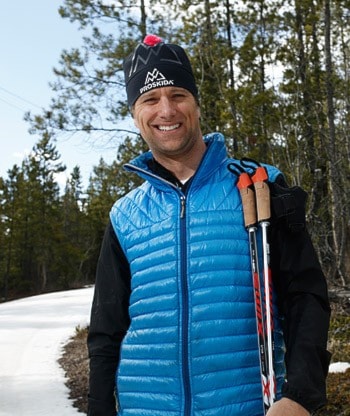By his own admission, Alastair Smith only took up cross-country skiing to impress his wife.
Before they were married, she was on the ski team at university, so he started skiing to spend time with her - as you do.
He kept it up when they later moved to Whitehorse because, as he puts it, “that’s what you do when you’re here.”
He’s never been a competitive skier. But now, Smith and two business partners, Anton and Hans Fischer, are working on a new, electronic ski pole that they hope will revolutionize the sport.
The three partners, whose company is called Proskida, have found a way to measure a skier’s power by inserting a tiny circuit board, a force sensor and a battery into the handle of a regular ski pole.
Smith hopes that skiers will use that information to become more efficient, and elite ski teams will use it to help decide which new athletes to recruit.
“As far as we know, there is nothing else out there like this,” he said. “Having access to this type of tool is definitely something that there’s interest in.”
Smith explained that when a skier grips the pole, the force sensor registers the pressure being applied. The circuit board, which is just about two centimetres long, holds a number of devices that collect information about the angle of the terrain and the skier’s acceleration.
All that information is sent wirelessly to a mobile app, which then calculates the skier’s force and power.
Smith said that information could make a big difference to how skiers’ ability is measured.
“With cross-country skiing, the conditions vary so much, and so there’s no way to compare one skier to another unless they’re racing each other,” he said. “There’s no way to compare your own performance day-to-day, because the conditions change so much all the time.”
But power is a true measure of a skier’s performance, he explained. Between two skiers of equal weight, the one with more power will always go faster.
Power meters are nothing new. They are ubiquitous among professional cyclists, and are quickly gaining popularity among amateurs as well.
Smith also said that rowers trying out for elite teams have to measure their power on a rowing machine.
“If you can’t output power at a certain rate, for a certain period of time, then you’re just not going to be quick enough,” he explained.
But until now, there hasn’t been an easy way to get similar data from cross-country skiers. Smith said that’s because skiing is so complex - with the skis and poles, it’s essentially a four-legged sport.
His invention only collects data from the poles, not the skis. But as the sport evolves, he said, more and more power is coming from the poles. These days, some skiers are racing just by double-poling, without moving their skis at all.
“At this point, the main focus is on how can we make poling more efficient,” he said.
The other change that’s made this invention possible is the smaller size of the technology.
“We’ve just hit that point where the electronics have gotten to a point where they’re miniature enough, they consume little enough power, that we can hide all of that in something that weighs just marginally more than a standard grip,” he explained.
Right now, Smith and his partners are working with Canada’s national cross-country ski team as they design their prototype. He said they’ve also had interest from teams in the United States, Scandinavia, Eastern Europe and Russia.
It’s all happened remarkably fast, given that the trio only started working on the project in mid-December.
Smith said the idea was born after Anton Fischer, an old high school friend, came to visit the Yukon. After his trip, he and Smith started emailing back and forth about whether they couldn’t create a power meter for skiers.
After all, Smith said, he has a background in computer science and Anton and his brother, Hans, are engineers.
“And it kind of snowballed and evolved from there,” Smith said.
Yukon College’s Technology Innovation fund has given them about $68,000 to develop the prototype. And they’ve been working with Whitehorse-based Make IT Solutions for the programming.
Now, they’re starting to look for private investors to help them move from the prototype phase into mass production. And they’d like the business to stay in the Yukon.
“We’re lucky to be based in the Yukon where normally we have good snow and have access to world-class skiers and world-class trails,” Smith said.
He said they’d likely sell the ski poles for about the same amount as bike power meters, which now average around $1,500.
That might seem like a lot, but Smith believes he’s tapped into a growing popular demand for more data about every aspect of daily life. We are used to having information at our fingertips, he said.
“Right now, it seems very specific, but if you think about Fitbits and heart-rate monitors, they’ve been around since the ‘80s at least as a consumer product,” he said. “And it was only the very top strata of athletes who were using them. And now, people are walking around, walking their dogs with their heart-rate monitor.”
Contact Maura Forrest at
maura.forrest@yukon-news.com
